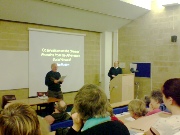


Menu

Search the PDAS site


OBSERVATIONS OF THE SKELETAL REMAINS FROM THE
ATHENAEUM BURIAL GROUND
Dr Ian Hodgins
21st January 2008

Part of a burial site behind Plymouth Athenaeum has been excavated by Exeter Archaeology prior to redevelopment. They found some decorated naval buttons and evidence that some of the bodies may have belonged to war casualties. The burial site is .........
thought to date from 1700-
This talk accompanied the Jan 2008 AGM and,although not strictly part of our winter lecture programme, is best placed in this section.
Chris Ruse introduces
Dr Ian Hodgins

He found four amputated limbs plus one that showed ‘slug’ marks which suggested the patient had survived two weeks after an amputation before succumbing to osteomyelitus. Two of these men had died as a result of surgery and were buried with their amputated limbs. The bones also included one with a primary tumour and another with a shrapnel wound as well as some fused ribs suggesting that they had belonged to someone who worked long hours with their arms raised, such as a painter.
Four of the amputations were of the upper leg and one of the upper arm. An examination of the amputated ends showed saw marks across the surfaces with the final portion snapping. The amputation of the upper arm had involved three re-
Joan Price
__________________
Winter
Lecture Reports
| January |
| February |
| March |
| April |
| May |
| June |
| July |
| August |
| Septmber |
| October |
| November |
| December |
| Pollen Analysis |
| Archaeology of Gardens |
| Identifying Prehistoric Pottery |